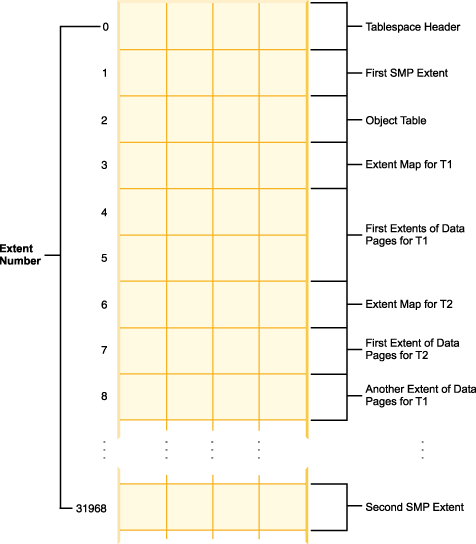In a DMS (database managed space) table space, the database manager controls the storage space. Unlike SMS table spaces, storage space is pre-allocated on the file system based on container definitions that you specify when you create the DMS table space.
The DMS storage model consists of a limited number of files or devices where space is managed by the database manager. You decide which files and devices to use when creating containers, and you manage the space for those files and devices.
A DMS table space containing user defined tables and data can be defined as a large (the default) or regular table space that stores any table data or index data. The maximum size of a regular table space is 512 GB for 32 KB pages. The maximum size of a large table space is 64 TB. See SQL and XML limits for the maximum size of regular table spaces for other page sizes.
There are two options for containers when working with DMS table spaces: files and raw devices. When working with file containers, the database manager allocates the entire container at table space creation time. A result of this initial allocation of the entire table space is that the physical allocation is typically, but not guaranteed to be, contiguous even though the file system is doing the allocation. When working with raw device containers, the database manager takes control of the entire device and always ensures the pages in an extent are contiguous. (An extent is defined as the number of pages that the database manager writes to a container before using a different container. )
When designing your DMS table spaces and containers, you should consider the following:
Attempting to create a table space smaller than five extents will result in an error (SQL1422N).
When working with DMS table spaces, you should consider associating each container with a different disk. This allows for a larger table space capacity and the ability to take advantage of parallel I/O operations.
The CREATE TABLESPACE statement creates a new table space within a database, assigns containers to the table space, and records the table space definition and attributes in the catalog. When you create a table space, the extent size is defined as a number of contiguous pages. Only one table or object, such as an index, can use the pages in any single extent. All objects created in the table space are allocated extents in a logical table space address map. Extent allocation is managed through space map pages.
The first extent in the logical table space address map is a header for the table space containing internal control information. The second extent is the first extent of space map pages (SMP) for the table space. SMP extents are spread at regular intervals throughout the table space. Each SMP extent is a bit map of the extents from the current SMP extent to the next SMP extent. The bit map is used to track which of the intermediate extents are in use.
The next extent following the SMP is the object table for the table space. The object table is an internal table that tracks which user objects exist in the table space and where their first extent map page (EMP) extent is located. Each object has its own EMPs which provide a map to each page of the object that is stored in the logical table space address map. Figure 1 shows how extents are allocated in a logical table space address map.
